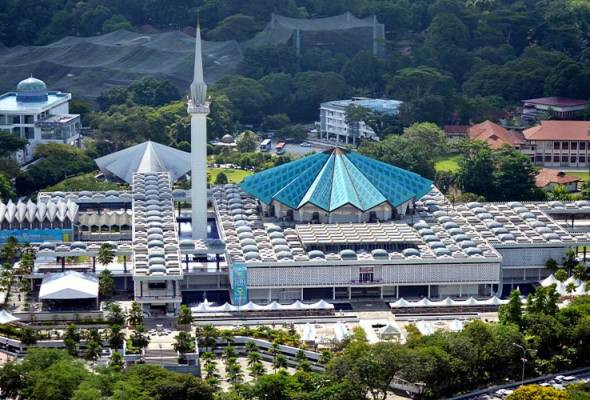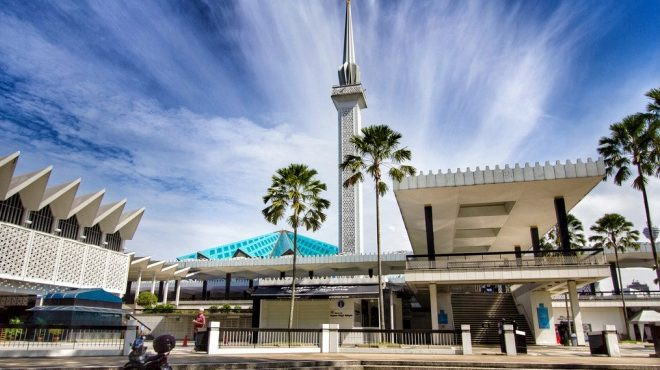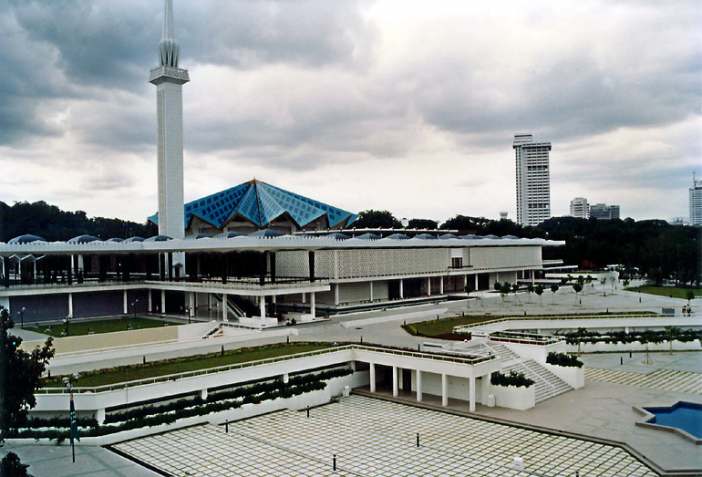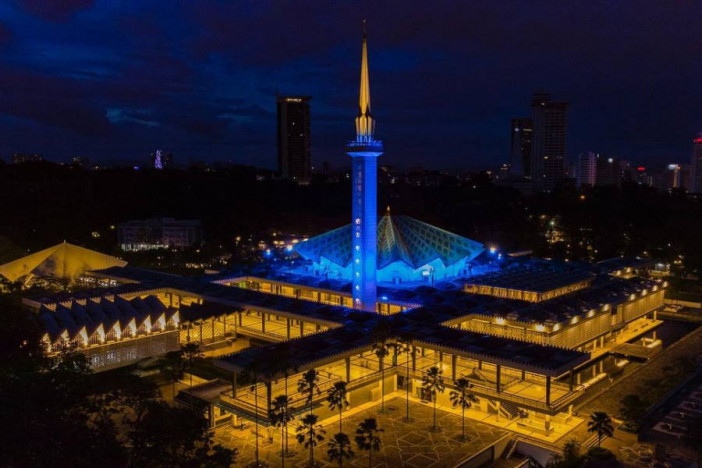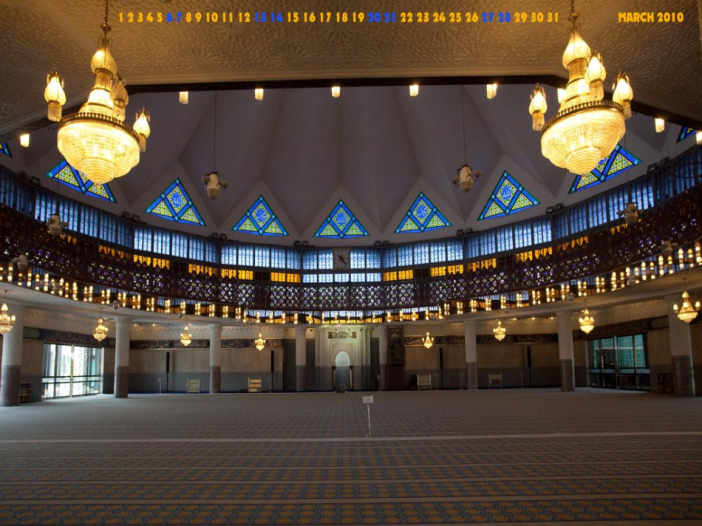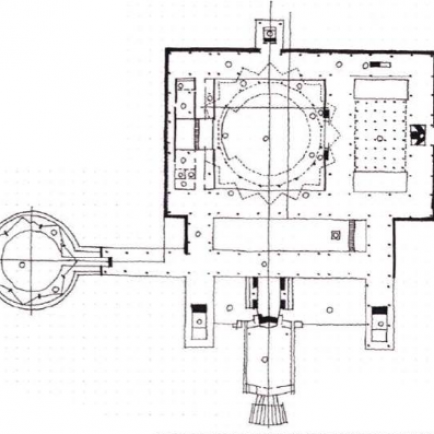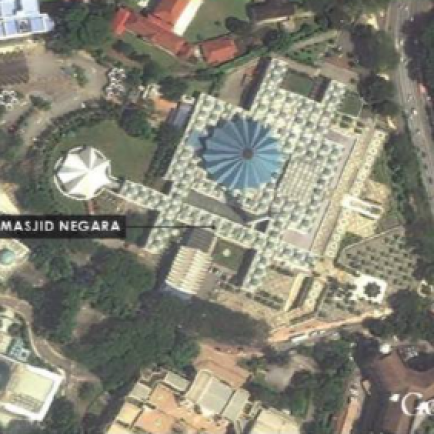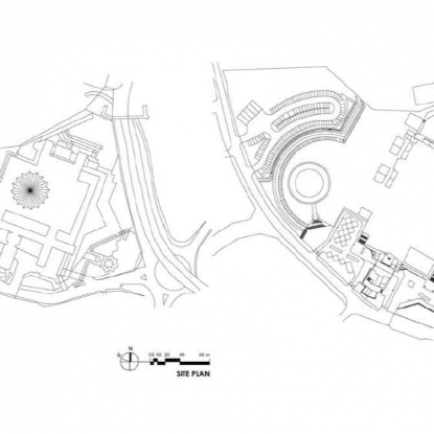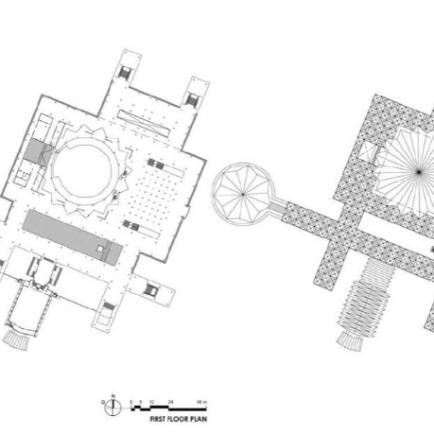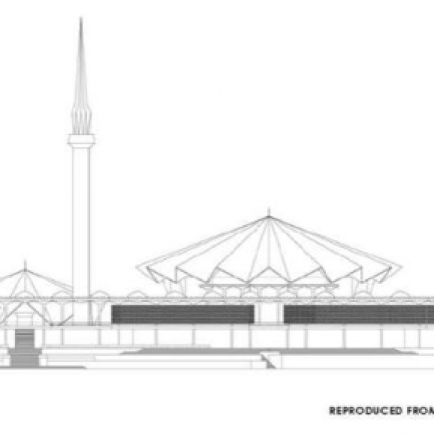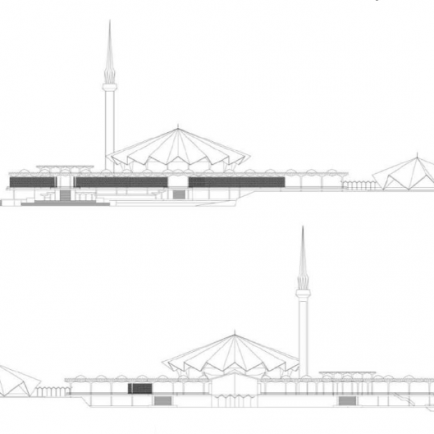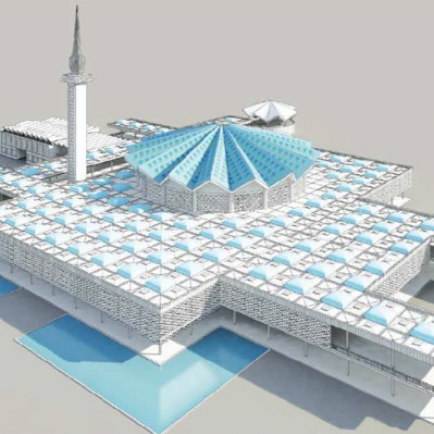The National Mosque of Malaysia
History
The mosque was built on the former site of a church, the Venning Road Brethren Gospel Hall, which was acquired by the government in 1961. The church was offered land on Jalan Imbi as a replacement and is now known as Jalan Imbi Chapel. The original structure of the mosque was designed by a three-person team from the Public Works Department: UK architect Howard Ashley, and Malaysians Ikmal Hisham Albakri and Baharuddin Kassim. The engineer in charge of the construction of the mosque, which commenced in 1963 was Antony Morris. On Friday, 27 August 1965, the mosque was declared open by the third Yang di-Pertuan Agong, the late Tuanku Syed Putra of Perlis.
The mosque underwent major renovations in 1987, and the once-pink concrete roof is now clad in green and blue tiles. Today, Masjid Negara continues to stand sleek and stylish against the Kuala Lumpur skyline. An underground passage leads to the National Mosque located near the railway station, along Jalan Sultan Hishamuddin. Its unique modern design embodies a contemporary expression of traditional Islamic art calligraphy and ornamentation. Near the mosque is the Makam Pahlawan (Heroes' Mausoleum), a burial ground of several Malaysian Muslim leaders. Makam Pahlawan is a 7-pointed star concrete roofed structure.
On 27 August 2015, Masjid Negara celebrated its Golden Jubilee (50th anniversary).
Urban and Architectural
The design and supervision of the building was done by a team of 3 architects from the Design and Research Division, Federal Public Works Department - architects Hisham Albakri, Howard Ashley (from the United Kingdom) and Dato Baharuddin Kassim. They took three years to complete. Before starting the work of designing the National Mosque, its main architect, Baharuddin Abu Kassim studied mosques in India , Pakistan , Iran , Turkey , Saudi Arabia , the United Arab Republic and Spain .
At first glance, its 73 -meter (245 -foot) high tower looks like a rocket. It is shaped like a budding umbrella while the 18 -pointed star -shaped concrete roof looks like a expanded umbrella. The shape of the towers and the polished roof of the National Mosque symbolizes loyalty. This concept is matched to the look of the Royal umbrella. The tower is shaped like a picture of a folded umbrella while the roof is shaped like an open umbrella.
The folded shape of the main concrete roof is a creative solution to achieve a large space for the prayer hall. The RM10 million building covers an area of five acres. It contains a 22,500 -square -foot prayer hall, conference hall, cemetery, library, office, courtyard, tower, royal chamber and a priest’s room. The cemetery for seven national heroes is located in the west. Also available is an air -conditioned radio and television room located in the prayer hall gallery.
The design is in line with the design of modern buildings but the Abbasid/Ottoman Turkish architecture is still preserved. The appearance of this mosque is the result of a mixture of Islamic and modern patterns and embroidered local architecture.
The shape of the iron railings that surround the building and the small domes that are above the veranda are based on the Sarasin design, but they are adapted to the modern design.
Description
The National Mosque of Malaysia is a national legacy. Built between 1963 and 1965, the idea to build a national mosque to commemorate Malaysia’s independence was brought up by the Federal Executive Council a month before the country celebrated its independence.
References
https://ms.wikipedia.org/wiki/Masjid_Negara
https://ms.wikipedia.org/wiki/Masjid_Negara
https://itc.gov.my/listings/masjid-negara/
Details
Location
Jalan Perdana, Tasik Perdana, 50480 Kuala Lumpur, Wilayah Persekutuan Kuala Lumpur, Malaysia
Worshippers
15,000
Owners
Malaysian Public Works Department
Architect Name
Howard L. Ashley
Ikmal Hisham Albakri
Dato Baharuddin Abu Kassim
Year of Build
1965
Area
7,575
Drawings
Map
History
The mosque was built on the former site of a church, the Venning Road Brethren Gospel Hall, which was acquired by the government in 1961. The church was offered land on Jalan Imbi as a replacement and is now known as Jalan Imbi Chapel. The original structure of the mosque was designed by a three-person team from the Public Works Department: UK architect Howard Ashley, and Malaysians Ikmal Hisham Albakri and Baharuddin Kassim. The engineer in charge of the construction of the mosque, which commenced in 1963 was Antony Morris. On Friday, 27 August 1965, the mosque was declared open by the third Yang di-Pertuan Agong, the late Tuanku Syed Putra of Perlis.
The mosque underwent major renovations in 1987, and the once-pink concrete roof is now clad in green and blue tiles. Today, Masjid Negara continues to stand sleek and stylish against the Kuala Lumpur skyline. An underground passage leads to the National Mosque located near the railway station, along Jalan Sultan Hishamuddin. Its unique modern design embodies a contemporary expression of traditional Islamic art calligraphy and ornamentation. Near the mosque is the Makam Pahlawan (Heroes' Mausoleum), a burial ground of several Malaysian Muslim leaders. Makam Pahlawan is a 7-pointed star concrete roofed structure.
On 27 August 2015, Masjid Negara celebrated its Golden Jubilee (50th anniversary).
Urban and Architectural
The design and supervision of the building was done by a team of 3 architects from the Design and Research Division, Federal Public Works Department - architects Hisham Albakri, Howard Ashley (from the United Kingdom) and Dato Baharuddin Kassim. They took three years to complete. Before starting the work of designing the National Mosque, its main architect, Baharuddin Abu Kassim studied mosques in India , Pakistan , Iran , Turkey , Saudi Arabia , the United Arab Republic and Spain .
At first glance, its 73 -meter (245 -foot) high tower looks like a rocket. It is shaped like a budding umbrella while the 18 -pointed star -shaped concrete roof looks like a expanded umbrella. The shape of the towers and the polished roof of the National Mosque symbolizes loyalty. This concept is matched to the look of the Royal umbrella. The tower is shaped like a picture of a folded umbrella while the roof is shaped like an open umbrella.
The folded shape of the main concrete roof is a creative solution to achieve a large space for the prayer hall. The RM10 million building covers an area of five acres. It contains a 22,500 -square -foot prayer hall, conference hall, cemetery, library, office, courtyard, tower, royal chamber and a priest’s room. The cemetery for seven national heroes is located in the west. Also available is an air -conditioned radio and television room located in the prayer hall gallery.
The design is in line with the design of modern buildings but the Abbasid/Ottoman Turkish architecture is still preserved. The appearance of this mosque is the result of a mixture of Islamic and modern patterns and embroidered local architecture.
The shape of the iron railings that surround the building and the small domes that are above the veranda are based on the Sarasin design, but they are adapted to the modern design.
Description
The National Mosque of Malaysia is a national legacy. Built between 1963 and 1965, the idea to build a national mosque to commemorate Malaysia’s independence was brought up by the Federal Executive Council a month before the country celebrated its independence.


